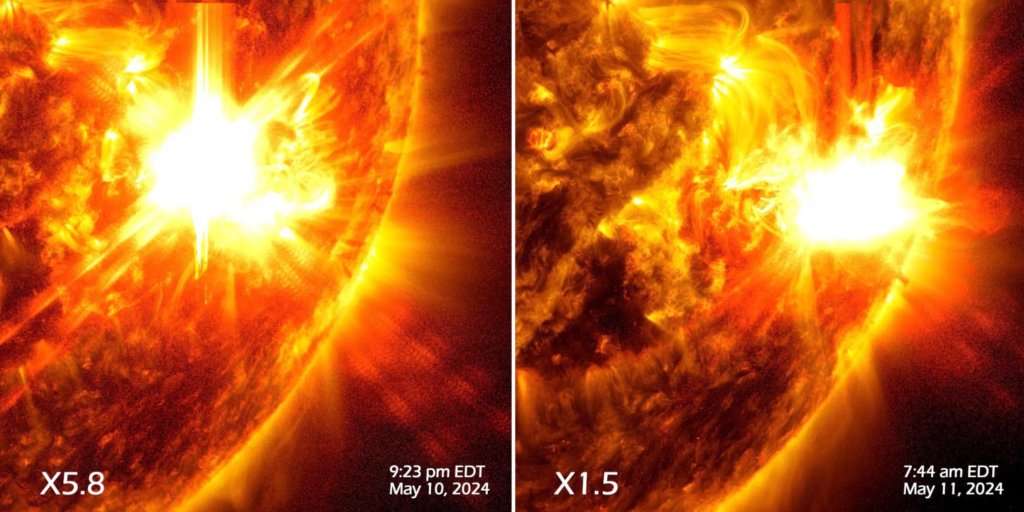Just when we thought we’d seen the most powerful flares from a colossal sunspot, the sun unleashed its strongest eruption of the weekend yet, triggering a radio blackout even as the star continues to crackle with solar storms.
According to NOAA’s Space Weather Prediction Center (SWPC), the dynamic solar flare occurred late Saturday (May 10) from an active sunspot region called AR3664. It peaked at 9:23 p.m. EDT (0123 May 11 GMT), registering as a massive X5.8 class flare, SWPC officials said. As a result, parts of some of the Earth’s sunlit side had temporary or complete loss of high frequency (HF) radio signals.
The sun, proving that it wasn’t done yet, also fired off a powerful X1.5 solar flare at 7:44 a.m. EDT (1144 GMT), NASA officials said. X-class flares are the strongest types of solar eruptions from the sun, and while flares can last anywhere from a few minutes to hours, to get these high magnitudes aren’t as common. Yet, the sun has fired off a series of powerful flares this week that have supercharged Earth’s northern lights displays.
NASA’s Solar Dynamics Observatory captured these two views of massive solar flares, registering X5.8 and X1.5, respectively, on May 11, 2024. (Image credit: NASA/SDO)
“Solar flares are powerful bursts of energy,” NASA wrote in a statement on the flares. “Flares and solar eruptions can impact radio communications, electric power grids, navigation signals, and pose risks to spacecraft and astronauts.”
According to the recent NOAA SWPC discussion, region 3664 has the potential to stay busy through Monday (May 13). High to very high levels of solar activity are expected with an increased likelihood for more flares in the top two classes, M and X. The active region is a massive sunspot complex about 17 times the width of Earth, NOAA SWPC officials said.
Related: Jaw-dropping northern lights from massive solar flares amaze skywatchers
Scientists have also noted that there was a coronal mass ejection (CME), a large expulsion of plasma and magnetic field, from the main eruption, which they are analyzing and modeling. This could bring additional impacts to Earth in the coming days including issues with power grids, telecommunication networks, and to satellites in orbit as well as another opportunity for a charged-up view of the northern lights for some locations!
Breaking space news, the latest updates on rocket launches, skywatching events and more!
Editor’s note: If you capture a stunning photo or video of the northern lights (or southern lights!) and want to share them with Space.com for a possible story, send images, comments on the view and your location, as well as use permissions to spacephotos@space.com.
Join our Space Forums to keep talking space on the latest missions, night sky and more! And if you have a news tip, correction or comment, let us know at: community@space.com.
Meredith is a regional Murrow award-winning Certified Broadcast Meteorologist and science/space correspondent. She most recently was a Freelance Meteorologist for NY 1 in New York City & the 19 First Alert Weather Team in Cleveland. A self-described “Rocket Girl,” Meredith’s personal and professional work has drawn recognition over the last decade, including the inaugural Valparaiso University Alumni Association First Decade Achievement Award, two special reports in News 12’s Climate Special “Saving Our Shores” that won a Regional Edward R. Murrow Award, multiple Fair Media Council Folio & Press Club of Long Island awards for meteorology & reporting, and a Long Island Business News & NYC TV Week “40 Under 40” Award.
>>> Read full article>>>
Copyright for syndicated content belongs to the linked Source : Space.com – https://www.space.com/sun-fires-off-massive-x-class-solar-flares-may-11-2024
